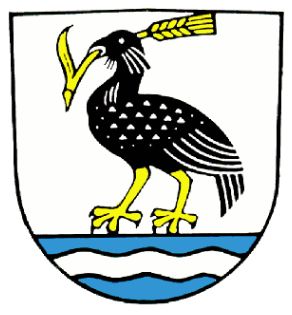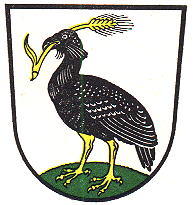Trappstadt: Difference between revisions
Knorrepoes (talk | contribs) m (Text replacement - "/Arms of " to "/Arms (crest) of ") |
Knorrepoes (talk | contribs) m (Text replacement - "{{media}}" to " {{de1}} {{media1}}") |
||
| Line 34: | Line 34: | ||
|} | |} | ||
{{ | |||
{{de1}} | |||
{{media1}} | |||
[[Civic Heraldry Literature - Germany|'''Literature''']]: Stadler, 1964-1971, 8 volumes; Hupp, O: [[Kaffee Hag albums]], 1920s | [[Civic Heraldry Literature - Germany|'''Literature''']]: Stadler, 1964-1971, 8 volumes; Hupp, O: [[Kaffee Hag albums]], 1920s | ||
Revision as of 11:25, 26 December 2022
This page is part of the German heraldry portal Deutsche Wappensammlung |
Heraldry of the World |
|
German heraldry:
|
Selected collector's items from Germany:
|
TRAPPSTADT
State : Bayern
District (Kreis) : Rhön-Grabfeld (until 1973 Königshofen im Grabfeld)
Additions : 1978 Alsleben
| German |
Über blauem Schildfuß, darin ein silberner Wellenbalken, in Silber eine schwarze Trappe mit goldenen Füßen, die einen goldenen Getreidehalm im Schnabel hält. |
| English | No blazon/translation known. Please click here to send your (heraldic !) blazon or translation |
Origin/meaning
The arms were officially granted on January 24, 1986.
The arms show a canting bird (Trapp=bustard). The village became a town (Markt) in 1778, but the oldest seal dates from around 1656. The seal shows, as do all later seals, already the bird as the symbol of the town.
In a later image the bird is placed on three small hills, which should represent the Höhberg, Spanshügel and Altenburg hills in the town. The arms were first officially granted in 1836, but there have been many interpretations of the arms during the years. The picture below shows the arms as granted in 1836.
| The arms from 1836 |
The arms by Hupp in the Kaffee Hag albums +/- 1925 |
| The arms in the Deutsches Wappenmuseum |
Literature: Stadler, 1964-1971, 8 volumes; Hupp, O: Kaffee Hag albums, 1920s





